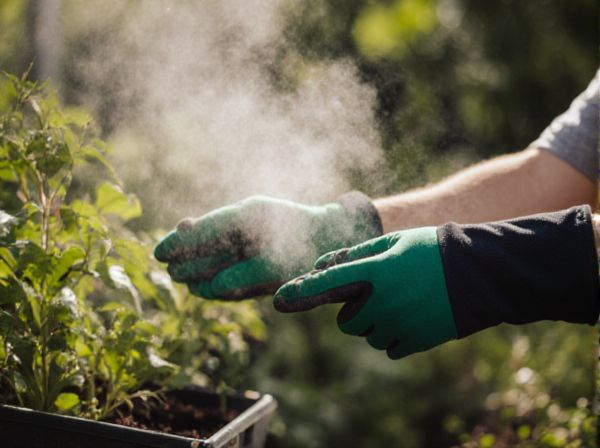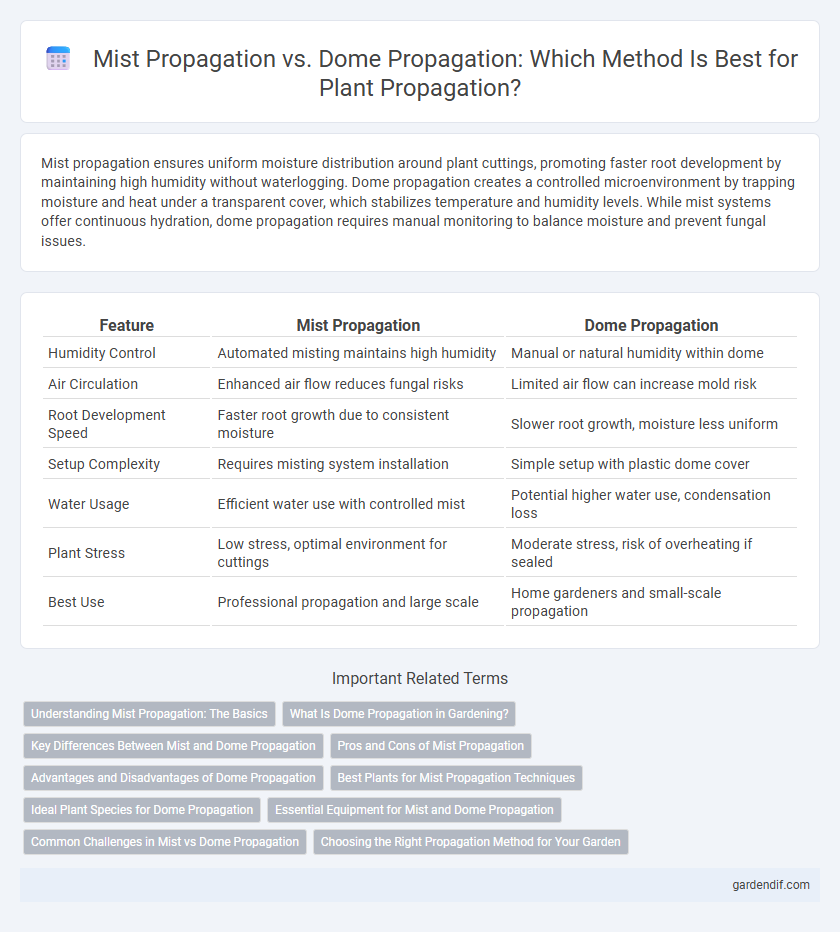
Mist Propagation vs Dome Propagation Illustration
Mist propagation ensures uniform moisture distribution around plant cuttings, promoting faster root development by maintaining high humidity without waterlogging. Dome propagation creates a controlled microenvironment by trapping moisture and heat under a transparent cover, which stabilizes temperature and humidity levels. While mist systems offer continuous hydration, dome propagation requires manual monitoring to balance moisture and prevent fungal issues.
Table of Comparison
| Feature | Mist Propagation | Dome Propagation |
|---|---|---|
| Humidity Control | Automated misting maintains high humidity | Manual or natural humidity within dome |
| Air Circulation | Enhanced air flow reduces fungal risks | Limited air flow can increase mold risk |
| Root Development Speed | Faster root growth due to consistent moisture | Slower root growth, moisture less uniform |
| Setup Complexity | Requires misting system installation | Simple setup with plastic dome cover |
| Water Usage | Efficient water use with controlled mist | Potential higher water use, condensation loss |
| Plant Stress | Low stress, optimal environment for cuttings | Moderate stress, risk of overheating if sealed |
| Best Use | Professional propagation and large scale | Home gardeners and small-scale propagation |
Understanding Mist Propagation: The Basics
Mist propagation involves nurturing plant cuttings in a controlled environment where a fine mist periodically wets the leaves, reducing water loss and promoting root development. This technique enhances humidity and moisture retention compared to dome propagation, which relies on a closed cover to maintain humidity but may risk mold buildup and less frequent hydration. Understanding mist propagation fundamentals reveals its advantage in providing consistent moisture and encouraging stronger root systems for successful plant propagation.
What Is Dome Propagation in Gardening?
Dome propagation involves covering plant cuttings with a clear plastic dome to create a humid microenvironment that promotes root development and reduces moisture loss. This method maintains consistent temperature and humidity levels, accelerating the rooting process compared to mist propagation, which relies on periodic water mist to keep cuttings hydrated. Gardeners use dome propagation especially for delicate seedlings and cuttings requiring stable humidity to improve survival rates and growth speed.
Key Differences Between Mist and Dome Propagation
Mist propagation utilizes a fine spray of water to maintain high humidity around cuttings, enhancing root development in plants sensitive to drying out. Dome propagation involves covering seedlings or cuttings with a transparent dome to create a controlled microenvironment that retains moisture and warmth but may not provide the constant misting essential for certain species. Key differences include mist propagation's active moisture delivery system versus dome propagation's passive humidity control, impacting rooting efficiency and suitability for various plant types.
Pros and Cons of Mist Propagation
Mist propagation offers superior humidity control and efficient water distribution, promoting faster rooting and reducing transplant shock in delicate plant cuttings. However, it requires specialized equipment and constant monitoring to prevent fungal diseases and over-saturation, which can damage young plants. Compared to dome propagation, mist systems provide a more uniform environment but come with higher initial costs and maintenance complexity.
Advantages and Disadvantages of Dome Propagation
Dome propagation offers a controlled environment that maintains consistent humidity and temperature, promoting faster rooting and reducing transplant shock in plants compared to mist propagation. However, dome propagation can lead to lower oxygen levels around the cuttings due to limited air circulation, increasing the risk of fungal diseases. While mist propagation provides constant moisture with better airflow, dome propagation is advantageous for delicate or slow-rooting species requiring a stable microclimate.
Best Plants for Mist Propagation Techniques
Mist propagation is ideal for moisture-loving plants such as ferns, orchids, and carnivorous species, as it maintains high humidity without waterlogging roots. Dome propagation suits succulents, herbs, and tropical plants by creating a warm, humid environment that reduces transplant shock while allowing better airflow. Selecting plants like African violets, basil, and begonias optimizes growth success in both mist and dome propagation methods.
Ideal Plant Species for Dome Propagation
Ideal plant species for dome propagation include moisture-loving herbs like basil, mint, and parsley that thrive in high-humidity environments created by domes. Tropical plants such as ginger, calathea, and philodendrons also benefit from dome propagation due to consistent warmth and humidity levels that promote root development. Succulents and cacti are generally less suited for dome propagation because excess moisture in domes can lead to rot.
Essential Equipment for Mist and Dome Propagation
Essential equipment for mist propagation includes misting systems, humidity domes, propagation trays, and heating mats to maintain consistent moisture and temperature levels crucial for rooting cuttings. Dome propagation requires clear plastic domes or humidity domes placed over trays to retain humidity, along with propagation mats to provide bottom heat, ensuring optimal conditions for seedling and cutting development. Both methods benefit from fans for air circulation and thermometers or hygrometers to monitor environmental conditions precisely.
Common Challenges in Mist vs Dome Propagation
Mist propagation often faces challenges such as inconsistent moisture levels and fungal growth due to prolonged wetness, which can hinder seedling development. Dome propagation commonly struggles with poor ventilation, leading to heat buildup and reduced oxygen availability that stress young plants. Both methods require precise environmental control to minimize disease risks and ensure optimal rooting conditions.
Choosing the Right Propagation Method for Your Garden
Mist propagation provides consistent moisture and oxygen, ideal for rooting delicate plant cuttings, while dome propagation maintains humidity and temperature, creating a controlled environment for seedlings and cuttings. Choose mist propagation for plants requiring precise moisture control and rapid root development; opt for dome propagation when nurturing young seedlings or when working with plants needing stable warmth and humidity. Assess plant type, climate, and propagation goals to determine the most effective propagation technique for your garden's success.
Mist Propagation vs Dome Propagation Infographic

 gardendif.com
gardendif.com